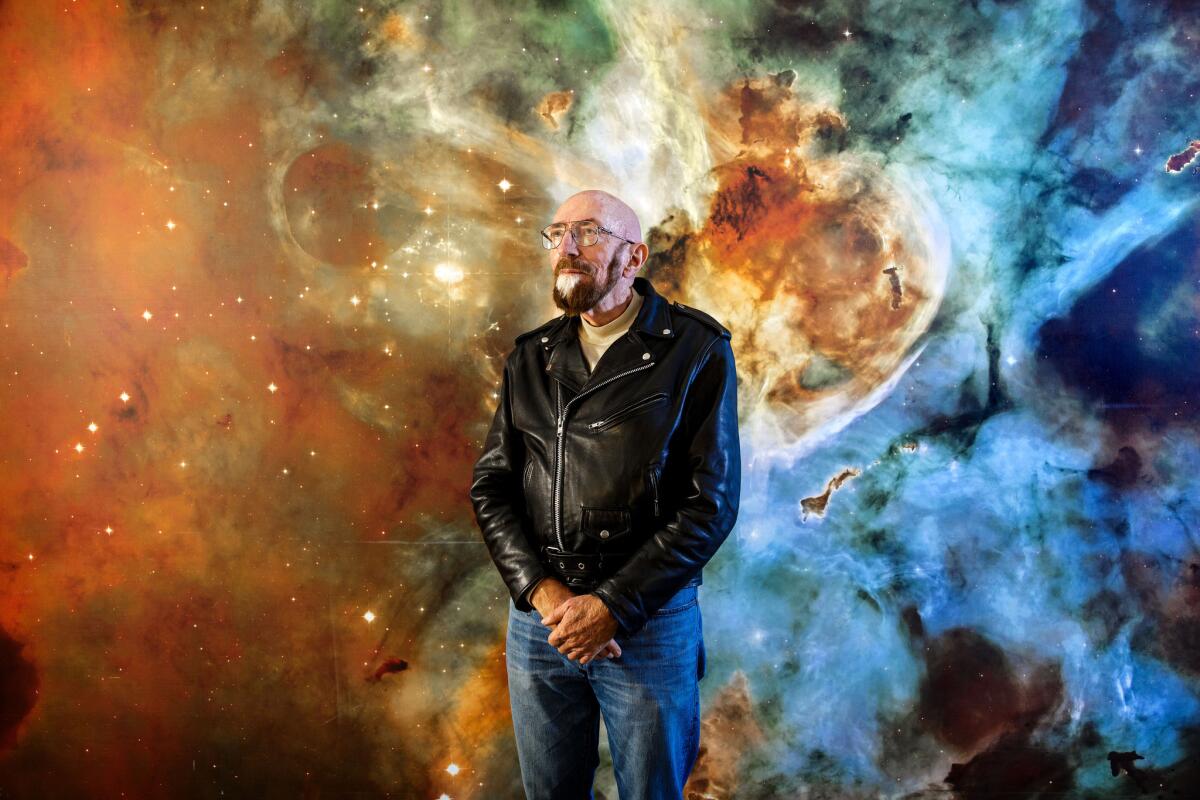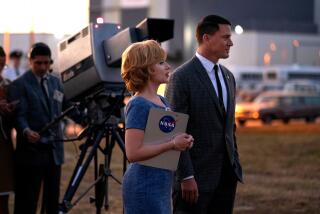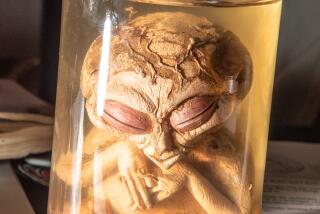Great Read: Meet the astrophysicist whose 1980 blind date led to ‘Interstellar’

- Share via
It started with a blind date.
Theoretical astrophysicist Kip Thorne was a divorced, single dad raising a teenage daughter when he got a call in September 1980 from a close friend — who happened to be fellow scientist Carl Sagan.
Would Thorne be interested in going out with a woman he knew?
Though the shy Caltech professor was far more comfortable contemplating black holes and other imponderables than he was navigating the world of dating, he said yes.
Thorne took his date, Lynda Obst, then a science editor at the New York Times Magazine, to the world premiere of Sagan’s TV series “Cosmos” at the Griffith Observatory. True to science-nerd form, Thorne wore a not very flattering tuxedo — he remembers it being baby blue, though Obst insists it was maroon.
“We really enjoyed each other’s company, but the romance never went anywhere,” Thorne said on a recent afternoon over lunch at the private faculty club at Caltech, the Athenaeum.
Through an improbable series of twists and turns, though, that blind date would lead to director Christopher Nolan’s new sci-fi epic, “Interstellar.”
Sci-fi movies are usually much more fi than sci, but “Interstellar” is deeply rooted in science. Wormholes, black holes, the fifth dimension — what Thorne calls “the warped side of the universe” — play critical roles in the story of a last-ditch space-exploration mission to find a new home for humankind.
“I can enjoy ‘Harry Potter’ and ‘Star Trek,’ but I really appreciate hard science fiction,” said Thorne, who has an executive producer credit on the film. “There have been far too few films of this type, in which the science is embedded in the fabric of the story.”
Thorne went to unusual lengths to ensure that, even where “Interstellar” veers into the realm of pure speculation, there is always some scientific justification to back it up.
During the film’s development, he led a daylong workshop in which 14 scientists, including astrobiologists, planetary scientists, psychologists and a space-policy expert, hashed out ideas. He worked closely with the film’s visual effects team to keep the film’s depictions of black holes and other cosmic phenomena as science-based as possible. He’s also written a book, “The Science of Interstellar,” as a companion to the movie.
Still, he knows he’ll catch flak from fellow scientists for some of the leaps the film makes.
“One eminent colleague here came out of a screening of ‘Interstellar’ and said, ‘I loved the movie but I have a few bones to pick with you about the science,’” Thorne said.
He shrugged.
“Look, I’m 74. I’ve had a career for half a century that I’ve thoroughly enjoyed. I’m not particularly sensitive to criticism anymore.”
::
That this scientist somehow wound up rubbing elbows with the likes of Matthew McConaughey and Anne Hathaway seems improbable on the face of it. Then again, when you’ve spent your career studying how space and time can bend and warp, normal ideas of what’s probable or improbable don’t really apply.
Since the start of his career, when he became one of the youngest full professors in the history of Caltech, Thorne has been a star among those who study the stars. (Caltech theoretical physicist John Preskill says of him: “Kip is a visionary scientist.”)
“I got a lot of notoriety early on,” Thorne said. “Much of my career I was just trying to prove I was as good as the world thought I was.”
Thorne retired in 2009 after more than 40 years of teaching. He doesn’t spend as much time on the Caltech campus as he used to, and he hardly ever eats at the staid, slightly stuffy Athenaeum.
“It’s a little hoity-toity for me,” he said, dressed unprofessorially in a black leather jacket and jeans. “But it’s a good place to talk.”
Though a self-described introvert, Thorne is also a born teacher, and he clearly enjoys talking. One moment he’s telling the story of how, in the mid-1970s, he won a scientific bet with his friend Stephen Hawking. The prize? A subscription to Penthouse magazine. (“You have to understand, I grew up in a Mormon culture — I thought that would be a fun thing to bet for.”) The next moment he’s patiently explaining how the imperceptible slowing of time due to Earth’s gravity affects the GPS system in the iPhone resting on the table.
Thorne had remained friends with Obst — who went on from journalism to a successful career as a film producer. Together, they concocted the original treatment for “Interstellar” in 2005.
At that point, the plot was quite different from that in the finished film. (“It involved going through a wormhole to explore things on the other side, but it wasn’t set in the future,” Thorne said.) But its core never changed.
“The idea was to explore the universe as it is,” Obst said. “We thought it was more interesting to look at what this stuff would actually look like than to make it up.”
Thorne had crossed paths with Hollywood only once before, when, in the early 1980s, he suggested to Sagan that he use a wormhole instead of a black hole to get a character in his screenplay for the film “Contact” from one point in space to the other.
If Thorne received a residual check every time a sci-fi movie or TV show has used a wormhole as a plot device since, he would be a far wealthier man.
Still, despite his lack of filmmaking know-how, Obst said Thorne’s way of approaching the mysteries of the universe made him an ideal cinematic collaborator.
“He’s an extremely imaginative scientist,” Obst said. “He once told me his idea of a big time is sitting on a stool on a mountain with a pencil in his hand — that’s all he needed. He loves to play intellectually.”
::
The fact is, Thorne didn’t initially set out to be a scientist at all. Raised in an academic family in a conservative area of Utah, his childhood career aspirations were far more earthbound.
“I wanted to be a snowplow driver when I was a kid,” he said. “Growing up in the Rocky Mountains, that’s the most glorious job you can imagine. But then my mother took me to a lecture about the solar system when I was 8 and I got hooked.”
The “Interstellar” treatment attracted Steven Spielberg, who signed on to direct. Hardly a movie buff, Thorne had seen only one of Spielberg’s films. (Perhaps not surprisingly, it was “E.T.: The Extra-Terrestrial.”)
But in 2010, Spielberg left the project, and it remained in limbo until late 2012, when Christopher Nolan came aboard and resurrected it.
Nolan admits he was initially wary of Thorne’s involvement.
“I was worried that he would just be the science police, telling me what I could and couldn’t do with my story,” said the director, who traces his own interest in space to watching Sagan’s “Cosmos” when he was 10. “But what I rapidly realized in talking to him was that he was able to offer me tremendously exciting narrative possibilities.
“The mind-blowing quality of real science — relativity, gravitational theory, black holes, wormholes — they’re far more exotic than anything I can come up with as a screenwriter.”
The scientist and the filmmaker only really came into conflict once, Nolan said. The director was determined to have a spacecraft in the film travel faster than the speed of light. Thorne balked at the idea.
“Over about two weeks, he finally wore me down and helped me understand that it was impossible according to the theory of relativity,” Nolan said.
Despite the success of “Interstellar,” Thorne doesn’t see a major new career in movies in his future. He has plenty of other things to keep him occupied: researching gravitational waves, writing a science fiction novel, scuba diving and skiing with his wife, Carolee Joyce Winstein, a professor of biokinesiology and physical therapy at USC.
“Lynda, Stephen Hawking and I have been talking about another movie project for a while — if that leads to something, it’s likely to be my last one,” Thorne said. (He declined to offer details, but it’s probably safe to assume it’s in the sci-fi genre.) “I’ve enjoyed this, but I’m at that point in my life where I want to do new things.
“I can’t imagine not being in a phase where I’m trying to understand something or create something,” he said. “That’s the essence of life.”
Twitter: @joshrottenberg
More to Read
Sign up for Essential California
The most important California stories and recommendations in your inbox every morning.
You may occasionally receive promotional content from the Los Angeles Times.











